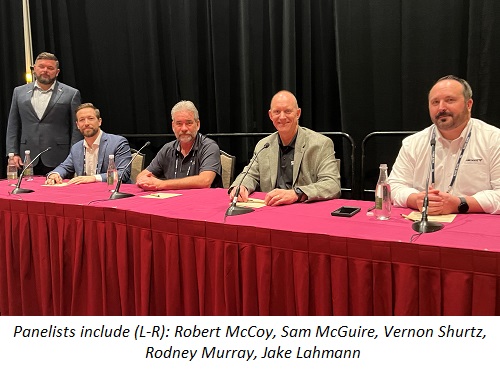NATE UNITE 2023
An estimated 85,000 unmanned aircraft system (UAS) flights took to the airspace around towers in 2022, according to statistics compiled by NATE. Better known as drones, these UAS flights saved the equivalent of 6,000 tower climbs. The ability to capture and document site data at towers is driving considerable momentum for the tower industry to use drones more extensively in tower maintenance and operations.
Robert McCoy with Crown Castle, Jake Lahmann from Valmont Site Pro 1, Sam McGuire of FieldSync Technologies, Rodney Murray from Skydio and Vern Shurtz at AUVSI, discussed the advantages and challenges in using drones at tower sites at a well-attended educational session titled, “Why Aren’t 100% of Tower Inspections Done with Drones?” at NATE UNITE 2023 this week.
Interest and momentum is growing in the industry to use drones in several ways. First is condition assessments and photographic “mapping” of equipment on a tower, where antennas, radios, cables are located.
In the early days, there would be a camera, at most, on a drone. Now they carry onboard computers that can be programmed so that the drones now know what they are looking at and can react to what they see in a semi-autonomous manner. The next step is to incorporate artificial intelligence so that tower inspections can be performed remotely and autonomously.
“We have come a long way in the last 10 years in terms of just basic controlling the drone to actually programming a very high power high speed computer onboard the drone,” Murray said. “Doing computation in real time or close to real time is a real game changer, because you can really begin to write software now that gives the power to the drone to actually understand what it’s looking at.”
The three-fold objective of such drone surveys is: data acquisition, processing, and analytics. This way data collection can be done in an efficient and safe manner without involving tower climbs. Once the data is acquired and processed, analytics can be applied to create an accurate “digital twin” that depicts what is on the tower. Using drones significantly reduces the costs and timing of the data acquisition while delivering very accurate information that both tower companies and their MNO tenants can use.
McGuire believes 100 percent of inspections will eventually be conducted with drones as an augmentation. “If you have a managed program where guys are out there making sure that your towers are in good shape and also remedying issues while they’re there, drones represent a really exciting opportunity to bring down the number of secondary touch points on the tower. So we see inspections, complemented by drones being a really huge opportunity, as well as mappings,” he said.
McCoy envisions a future where drones will get even smarter and more productive. “As technology advances, sensors will get better and you will be able to do more on the analytics side,” he said. “I see a lot with AI in terms of computer vision and identifying what type of antenna or radio they’re looking at. I see a lot in terms of modeling for measurement. I see advancements in technology giving you the ability now to take a computer model and actually draw polygon lines on it and get fairly accurate measurements.”
Along with condition assessments and photogrammetry for mapping the towers, Valmont uses drones to interact with the structures, developing robotics to install sensors and clean towers. “We are pushing the envelope of what a drone can do,” Lahmann said.
The next big thing, according to Murray, will be the ability to have a drone in the box at the tower site, which can be controlled remotely.
By John Celentano, Inside Towers Business Editor and J. Sharpe Smith, Inside Towers Technology Editor





Reader Interactions